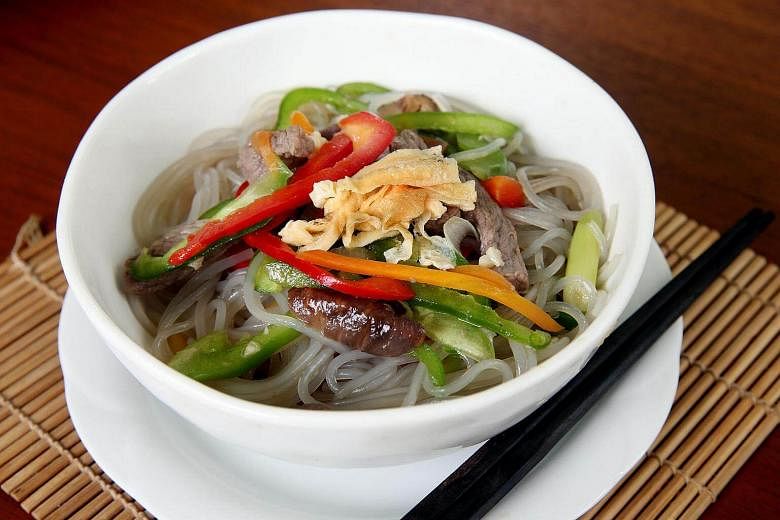We eat rice most days or a bowl of noodles. And I love it.
Yes, I love my carbs and blame all those years of eating meals around a bowl of rice for this habit.
Indeed, I have friends who must follow every mouthful of fish or meat with one of rice. We augment the problem by eating white rice.
But carbs like white rice and noodles add calories and cause dramatic hikes in blood sugar levels.
While all carbs provide essential fuel for the body, overconsumption of refined carbohydrates leads to weight gain and high levels of triglycerides in the blood.
-
Jap Chae (Korean sweet potato noodles)

-
INGREDIENTS
•1 medium-sized red onion, peeled and sliced finely
•3 cloves garlic, peeled and chopped finely
•1 medium-sized carrot, peeled and cut into matchsticks
•6 dried shitake mushrooms, soaked to soften, cut into strips
•1 red pepper, 1 green pepper, 1 yellow pepper - seeds and pith removed, julienned
•300g beef fillet, cut into strips
•300g dried sweet potato noodles from Korean shops
•2 stalks spring onion, sliced diagonally
SEASONING
•2 tbsp light soya sauce
•1 tbsp mirin (Japanese sweet rice wine) to taste
•2 tbsp sesame oil
GARNISH
•1 tbsp roasted white sesame seeds
•Chilli powder (optional)
•Omelette strips, made from 1 egg
METHOD
• Cut vegetables to the same size.
•Heat water in a pot. When boiling, add the dried noodles. Allow to soften for six to eight minutes.
• Drain noodles and rinse under a cold tap. If you like, cut noodles into shorter lengths. Set aside.
• Prepare the sauce, adjusting according to individual taste.
• Heat 1 tbsp vegetable oil, and saute the onions and garlic.
•Add the carrots and mushroom strips. After a few minutes, add
the julienned peppers.
• Add the beef, then the seasoning sauce. Saute for a few minutes.
• Finally, add the noodles and spring onions. Toss well.
• Serve topped with egg strips, sesame seeds and chilli powder.
SERVES FOUR TO SIX
On the other hand, eating carbohydrates with a low glycemic index, a measure of the effect of foods on blood sugar levels, encourages a steady rise in the level of glucose in the blood, leading to a small rise in insulin.
This keeps you full and energised for hours after eating and also encourages the body to burn fat.
So watch the amount you eat and focus instead on whole grains, beans, fruit and vegetables.
You could also look for carbs with a low glycemic index that do not prompt a sharp hike in your blood- sugar levels. They include brown rice, basmati rice, buckwheat (soba) noodles, glass noodles and Korean sweet potato noodles, which have less carbs than wheat noodles.
Korean sweet potato noodles are dried noodles made with sweet potato starch and water. They are slightly grey and transparent, with a chewy, slippery texture when cooked.
You cook them in boiling water, then drain and rinse them before using in salads, soups or stir-fries.
There is a classic Korean stir-fry, using sweet potato noodles, called jap chae. There are lots of things to like about jap chae. It has a wide selection of vegetables in it and only a scant amount of beef.
You could skip the beef and make it vegetarian. It is ideal for parties as you can eat it cold or warm. Though this is a stir-fry, it uses little oil. Just be careful with the amount of sugar you add to the dish.
Traditionally, the noodles are seasoned with soya sauce, sesame oil and sugar. I use mirin instead for an extra depth of flavour.
I like a melange of colour, so I choose vegetables that create a pretty picture. But I make sure they all take about the same time to cook. For this reason, I cut them more or less the same size.
While traditional recipes call for the vegetables to be fried separately, I find the order in which you add them to the pan ensures perfect cooking. Fry the harder vegetables first and just stir in the soft vegetables at the end.
And do not forget that scattering of white sesame seeds and the yellow omelette strips - they add sunshine to an already cheerful dish.
• Sylvia Tan is a freelance writer and cookbook author. Her previous Eat To Live recipes can be found in two cookbooks, Eat To Live and Taste.

